初中英语教案格式
初中英语教案的标准格式范文(共6篇)
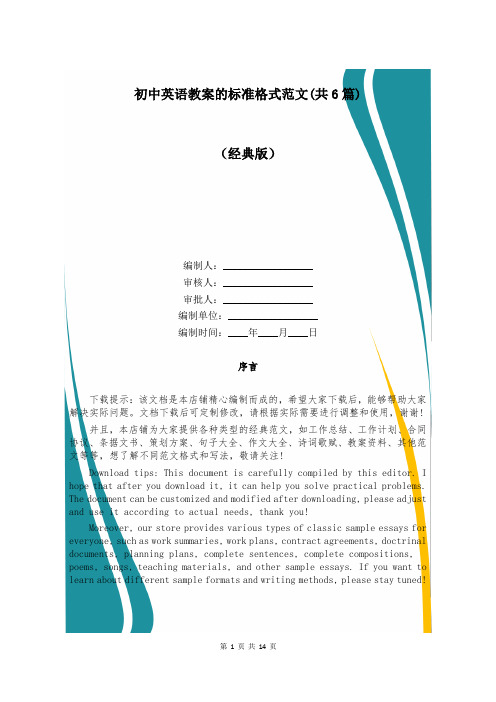
初中英语教案的标准格式范文(共6篇)(经典版)编制人:__________________审核人:__________________审批人:__________________编制单位:__________________编制时间:____年____月____日序言下载提示:该文档是本店铺精心编制而成的,希望大家下载后,能够帮助大家解决实际问题。
文档下载后可定制修改,请根据实际需要进行调整和使用,谢谢!并且,本店铺为大家提供各种类型的经典范文,如工作总结、工作计划、合同协议、条据文书、策划方案、句子大全、作文大全、诗词歌赋、教案资料、其他范文等等,想了解不同范文格式和写法,敬请关注!Download tips: This document is carefully compiled by this editor. I hope that after you download it, it can help you solve practical problems. The document can be customized and modified after downloading, please adjust and use it according to actual needs, thank you!Moreover, our store provides various types of classic sample essays for everyone, such as work summaries, work plans, contract agreements, doctrinal documents, planning plans, complete sentences, complete compositions, poems, songs, teaching materials, and other sample essays. If you want to learn about different sample formats and writing methods, please stay tuned!初中英语教案的标准格式范文(共6篇)初中英语教案的标准格式范文第1篇教学目标:(1)能听懂What’s your?并能根据实际情况用Hes/Shes…回答。
初中英语教案模板(优秀8篇)
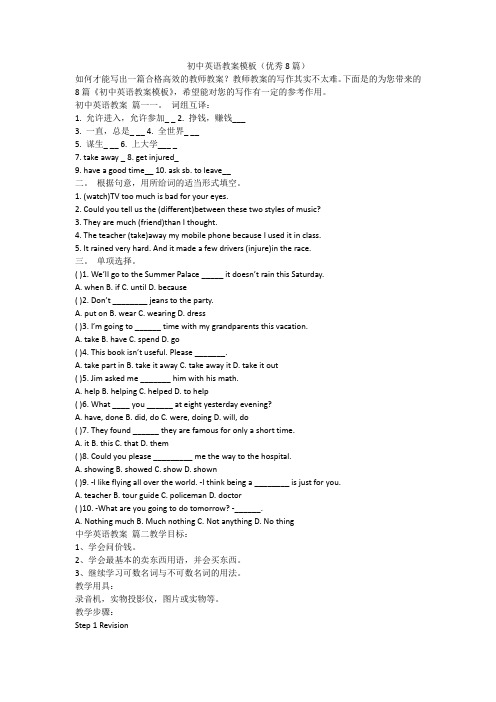
初中英语教案模板(优秀8篇)如何才能写出一篇合格高效的教师教案?教师教案的写作其实不太难。
下面是的为您带来的8篇《初中英语教案模板》,希望能对您的写作有一定的参考作用。
初中英语教案篇一一。
词组互译:1. 允许进入,允许参加_ _2. 挣钱,赚钱___3. 一直,总是_ __4. 全世界_ __5. 谋生_ __6. 上大学___ _7. take away _ 8. get injured_9. have a good time__ 10. ask sb. to leave__二。
根据句意,用所给词的适当形式填空。
1. (watch)TV too much is bad for your eyes.2. Could you tell us the (different)between these two styles of music?3. They are much (friend)than I thought.4. The teacher (take)away my mobile phone because I used it in class.5. It rained very hard. And it made a few drivers (injure)in the race.三。
单项选择。
( )1. We’ll go to the Summer Palace _____ it doesn’t rain this Saturday.A. whenB. ifC. untilD. because( )2. Don’t ________ jeans to the party.A. put onB. wearC. wearingD. dress( )3. I’m going to ______ time with my grandparents this vacation.A. takeB. haveC. spendD. go( )4. This book isn’t useful. Please _______.A. take part inB. take it awayC. take away itD. take it out( )5. Jim asked me _______ him with his math.A. helpB. helpingC. helpedD. to help( )6. What ____ you ______ at eight yesterday evening?A. have, doneB. did, doC. were, doingD. will, do( )7. They found ______ they are famous for only a short time.A. itB. thisC. thatD. them( )8. Could you please _________ me the way to the hospital.A. showingB. showedC. showD. shown( )9. -I like flying all over the world. -I think being a ________ is just for you.A. teacherB. tour guideC. policemanD. doctor( )10. -What are you going to do tomorrow? -______.A. Nothing muchB. Much nothingC. Not anythingD. No thing中学英语教案篇二教学目标:1、学会问价钱。
初中英语教案格式模板范文
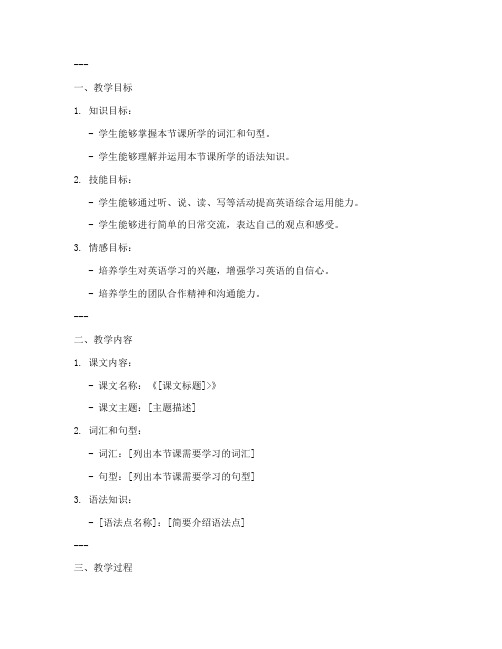
---一、教学目标1. 知识目标:- 学生能够掌握本节课所学的词汇和句型。
- 学生能够理解并运用本节课所学的语法知识。
2. 技能目标:- 学生能够通过听、说、读、写等活动提高英语综合运用能力。
- 学生能够进行简单的日常交流,表达自己的观点和感受。
3. 情感目标:- 培养学生对英语学习的兴趣,增强学习英语的自信心。
- 培养学生的团队合作精神和沟通能力。
---二、教学内容1. 课文内容:- 课文名称:《[课文标题]>》- 课文主题:[主题描述]2. 词汇和句型:- 词汇:[列出本节课需要学习的词汇]- 句型:[列出本节课需要学习的句型]3. 语法知识:- [语法点名称]:[简要介绍语法点]---三、教学过程1. 导入(5分钟)- 活动一:利用图片、视频或歌曲等导入新课,激发学生的学习兴趣。
- 活动二:进行简单的师生互动,复习与新课相关的旧知识。
2. 新课讲解(20分钟)- 活动一:教师讲解课文内容,重点讲解词汇、句型和语法知识。
- 活动二:通过示例句和练习题,帮助学生理解和掌握新知识。
3. 课堂练习(15分钟)- 活动一:进行词汇和句型练习,巩固所学知识。
- 活动二:进行语法练习,提高学生的语法运用能力。
4. 小组活动(15分钟)- 活动一:分组进行角色扮演,模拟课文场景,提高学生的口语表达能力。
- 活动二:小组讨论,分享对课文的理解和感受。
5. 总结与作业布置(5分钟)- 活动一:教师对本节课的内容进行总结,强调重点和难点。
- 活动二:布置课后作业,包括词汇记忆、句型练习和语法练习。
---四、教学评价1. 课堂表现:- 观察学生的参与度、回答问题的准确性等。
2. 作业完成情况:- 检查学生的作业完成情况,了解学生的学习效果。
3. 单元测试:- 通过单元测试,评估学生对本节课内容的掌握程度。
---五、教学反思- 教师对本节课的教学效果进行反思,总结经验教训,为今后的教学提供参考。
---备注:- 本教案仅供参考,教师可根据实际情况进行调整。
初中英语教案完整版

初中英语教案完整版初中英语教案完整版篇一:初三英语全套教案九年级全一册英语学案及教学设计unit 1 How do you study for a test?一、教学目标1、语言目标1)询问别人的学习方法2)学习讨论各种学习方法和策略,学会评价各种学习方法的优劣2、知识目标1)How do you study for a test?I study by ving .2) the way to do sththe way of doing sthhave trouble doing sth 的用法3、能力目标1)通过讨论找到适合自己的学习方法,找出自己在英语学习中的困难2)学会给出关于学习方法的建议二、重点知识1、重点单词flashcard vocabulary aloud pronunciation memorize grammar frustrating quickly spoken pronounce mistakes challenge solution realize matter afraid complete impress trouble soft deal unless regard influence friendship development face基本要求:会读、会写、会用。
2、重点短语make mistakes be afraid to do sth laugh at enjoy doing sth the way to do sth have trouble doing sthend upspoken English practice doing sth too much look upmake vocabulary liststry one`s best to do sth基本要求:会读、会写、会用。
3、重点语法1)How 引起的特殊疑问句及其回答2)the way to do sth the way of doing sthhave trouble doing sth 的用法基本要求:理解其含义,学以致用。
英语教案格式初中
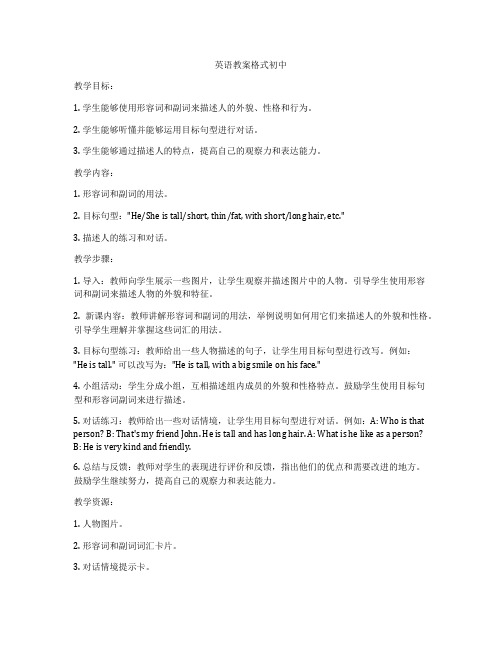
英语教案格式初中教学目标:1. 学生能够使用形容词和副词来描述人的外貌、性格和行为。
2. 学生能够听懂并能够运用目标句型进行对话。
3. 学生能够通过描述人的特点,提高自己的观察力和表达能力。
教学内容:1. 形容词和副词的用法。
2. 目标句型:"He/She is tall/short, thin/fat, with short/long hair, etc."3. 描述人的练习和对话。
教学步骤:1. 导入:教师向学生展示一些图片,让学生观察并描述图片中的人物。
引导学生使用形容词和副词来描述人物的外貌和特征。
2. 新课内容:教师讲解形容词和副词的用法,举例说明如何用它们来描述人的外貌和性格。
引导学生理解并掌握这些词汇的用法。
3. 目标句型练习:教师给出一些人物描述的句子,让学生用目标句型进行改写。
例如:"He is tall." 可以改写为:"He is tall, with a big smile on his face."4. 小组活动:学生分成小组,互相描述组内成员的外貌和性格特点。
鼓励学生使用目标句型和形容词副词来进行描述。
5. 对话练习:教师给出一些对话情境,让学生用目标句型进行对话。
例如:A: Who is that person? B: That's my friend John. He is tall and has long hair. A: What is he like as a person? B: He is very kind and friendly.6. 总结与反馈:教师对学生的表现进行评价和反馈,指出他们的优点和需要改进的地方。
鼓励学生继续努力,提高自己的观察力和表达能力。
教学资源:1. 人物图片。
2. 形容词和副词词汇卡片。
3. 对话情境提示卡。
评估方式:1. 观察学生在小组活动中的描述能力和对话中的运用能力。
初中英语教案教案格式

初中英语教案教案格式教学目标:1. 能够听懂、会说、会读本课的生词和重点句子。
2. 能够通过图片和情景对话,掌握询问时间、地点和表达喜好的句子结构。
3. 能够运用所学知识,进行简单的日常交流。
教学内容:1. 生词:restaurant, hotel, post office, supermarket, bank, hospital, library, gym, next to, between, opposite, on the corner of2. 重点句子:- How do you get to the...?- The... is next to the...- The... is between the... and the...- The... is opposite the...- The... is on the corner of... and...教学步骤:Step 1: 热身(5分钟)1. 老师与学生用中文进行简单的交流,询问学生的日常喜好,如:“你喜欢吃饭还是吃火锅?”、“你喜欢看电影还是打篮球?”等。
2. 学生用中文回答,同时用英语翻译自己的回答。
Step 2: 引入(10分钟)1. 老师出示一张城市地图,引导学生观察地图上的各种地点,如:“餐厅”、“酒店”、“邮局”等。
2. 老师用中文解释地图上的各个地点,同时用英语翻译。
Step 3: 生词学习(15分钟)1. 老师逐一出示生词卡片,引导学生跟读,并用中文解释生词的含义。
2. 学生用英语重复生词,并用中文解释生词的含义。
Step 4: 情景对话(20分钟)1. 老师出示一组图片,每张图片上都有一个地点,如:“餐厅”、“邮局”等。
2. 老师用英语提问:“How do you get to the...?”,学生用英语回答。
3. 学生两人一组,根据图片上的地点,用英语进行情景对话。
Step 5: 小组活动(15分钟)1. 学生分成小组,每组一张城市地图。
初中英语教案(优秀5篇)
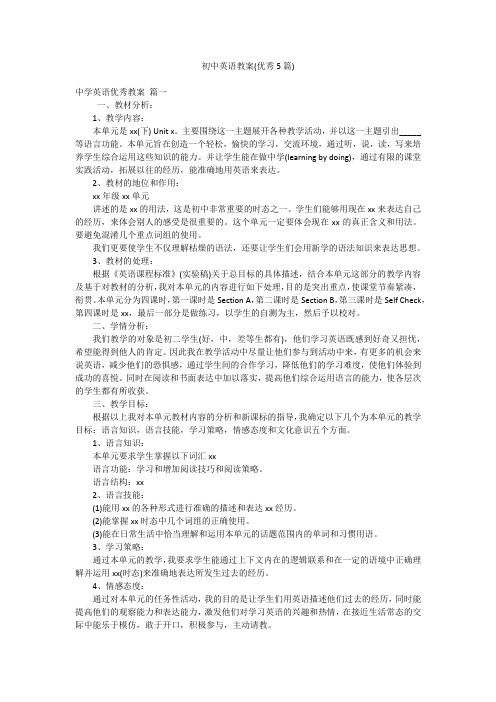
初中英语教案(优秀5篇)中学英语优秀教案篇一一、教材分析:1、教学内容:本单元是xx(下) Unit x。
主要围绕这一主题展开各种教学活动,并以这一主题引出_____等语言功能。
本单元旨在创造一个轻松,愉快的学习,交流环境,通过听,说,读,写来培养学生综合运用这些知识的能力。
并让学生能在做中学(learning by doing),通过有限的课堂实践活动,拓展以往的经历,能准确地用英语来表达。
2、教材的地位和作用:xx年级xx单元讲述的是xx的用法,这是初中非常重要的时态之一。
学生们能够用现在xx来表达自己的经历,来体会别人的感受是很重要的。
这个单元一定要体会现在xx的真正含义和用法。
要避免混淆几个重点词组的使用。
我们更要使学生不仅理解枯燥的语法,还要让学生们会用新学的语法知识来表达思想。
3、教材的处理:根据《英语课程标准》(实验稿)关于总目标的具体描述,结合本单元这部分的教学内容及基于对教材的分析,我对本单元的内容进行如下处理,目的是突出重点,使课堂节奏紧凑,衔贯。
本单元分为四课时,第一课时是Section A,第二课时是Section B,第三课时是Self Check,第四课时是xx,最后一部分是做练习,以学生的自测为主,然后予以校对。
二、学情分析:我们教学的对象是初二学生(好,中,差等生都有),他们学习英语既感到好奇又担忧,希望能得到他人的肯定。
因此我在教学活动中尽量让他们参与到活动中来,有更多的机会来说英语,减少他们的恐惧感,通过学生间的合作学习,降低他们的学习难度,使他们体验到成功的喜悦。
同时在阅读和书面表达中加以落实,提高他们综合运用语言的能力,使各层次的学生都有所收获。
三、教学目标:根据以上我对本单元教材内容的分析和新课标的指导,我确定以下几个为本单元的教学目标:语言知识,语言技能,学习策略,情感态度和文化意识五个方面。
1、语言知识:本单元要求学生掌握以下词汇xx语言功能:学习和增加阅读技巧和阅读策略。
初中英语教案的标准格式5篇
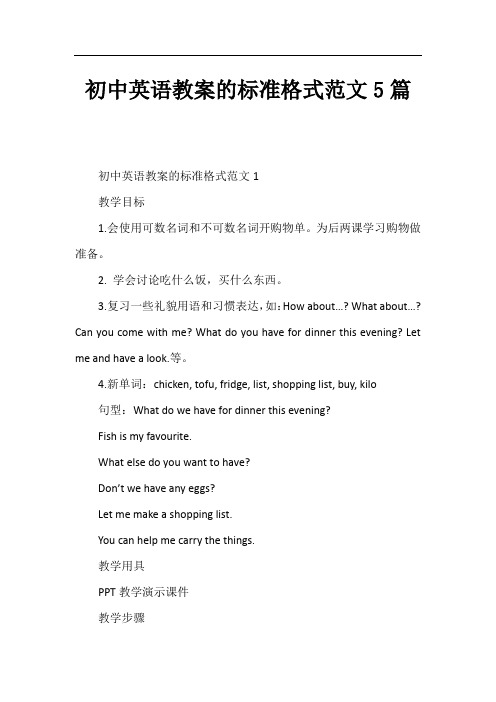
初中英语教案的标准格式范文5篇初中英语教案的标准格式范文1教学目标1.会使用可数名词和不可数名词开购物单。
为后两课学习购物做准备。
2. 学会讨论吃什么饭,买什么东西。
3.复习一些礼貌用语和习惯表达,如:How about…? What about…? Can you come with me? What do you have for dinner this evening? Let me and have a look.等。
4.新单词:chicken, tofu, fridge, list, shopping list, buy, kilo句型:What do we have for dinner this evening?Fish is my favourite.What else do you want to have?Don’t we have any eggs?Let me make a shopping list.You can help me carry the things.教学用具PPT教学演示课件教学步骤Step 1 Revision[课件展示]教师在课堂上提问题,引导学生回答What do you have for breakfast today? Shall we go and buy something to eat? What’s in the pictures? Let me see. What do we have for lunch today? How about…? What about…? What else do you want to have? Can you go and buy the things? Let’s go.等。
老师也可以同样的方式提问全班同学。
教师展示课件中Revision的食物图片,复习一些食品的名称。
Step 2 Presentation[课件展示]教师在复习食品名称基础上,引出购物的话题。
- 1、下载文档前请自行甄别文档内容的完整性,平台不提供额外的编辑、内容补充、找答案等附加服务。
- 2、"仅部分预览"的文档,不可在线预览部分如存在完整性等问题,可反馈申请退款(可完整预览的文档不适用该条件!)。
- 3、如文档侵犯您的权益,请联系客服反馈,我们会尽快为您处理(人工客服工作时间:9:00-18:30)。
初中英语教案格式
一、说教材(教材分析) Analyzing teaching material
1. 说课型 lesson type (Dialogue/ reading/ listening/ revision)
2. 本课在教材中的地位 status and function
Lesson 33 Saving the Earth is a dialogue. The lesson is focused on the topic of the problems of the earth and the functional items of Supposition/ Intentions/ conjecture/ Prohibition. Since it is a dialogue / reading. It’s helpful to improve the Ss communicative/ reading ability.
3. 说教学指导思想 teaching guideline
(Teaching syllabus: Language is for communication, develop their four skills, lay special emphasis on reading; Grellet put it well in his book developing reading skills:develop reading skill/ discourse analysis; get them to understand the western culture better; improve the ability to discover, analyze & solve the problems; Reading is for information, for fun; Use Top- down model or Bottom- up model to activate Ss schemata; Interactive model)
4. 说教学目标和要求Teaching aims and demands (…be intended for Ss in key schools)
1)认知目标 knowledge objects
a. Enable the Ss to remember the following new words & phrases:
Damage, lecture, pollute, pollution, room, standing room, be fit for, hear about, turn into
b. Get the Ss to be familiar with this sentence pattern:
If the population keeps growing so quickly, there will only be standing room left…
Give the Ss a reinforced practice on the functional item Supposition.
c. Activate Ss schemata regarding the topic of pollution and help Ss to know more about the problem of pollution.
2)智能目标 ability objects
a. Ask the Ss to make up a similar dialogue.
b. Help them to understand the dialogue better and improve the four skills.
c. Develop their ability of thinking independently.
d. Cultivate their ability to discover, analyze and
solve problems.
e. Train them to collect information from the Internet.
f. Train them with some effective learning methods to optimize Ss’ learning res ults.
3)德育目标 moral objects
a. Arouse their interest in learning English;
b. Help them to understand the background of pollution.
c. Enable the students to love our earth and the nature.
d. Be aware of the importance of stopping pollution & protecting out environment.
e. Encourage the Ss to do something to save the earth.
5. 说教学重点 teaching important points (生词、句型;培养阅读技能)
a. New words and phrases
b. Sentence pattern: If- clause
c. improve their reading skills.
d. Talking about problems of the Earth.
6. 说教学难点 teaching difficult points (语法;发展交际水平)
a. functional item: Supposition.
b. Develop their communicative ability. Act out their own dialogue.
7. 说教具 teaching aids (multi-media computer, software, OHP)
The teaching syllabus says that it’s necessary for teachers to use modern teaching facilities. It’s of great help to increase the class density and improve our teaching result. It can also make the Ss reach a better understanding of the text by making the classes lively and interesting. At the same time, it arouses the Ss’ interest in learning English.
二、说教法 Teaching methods。
